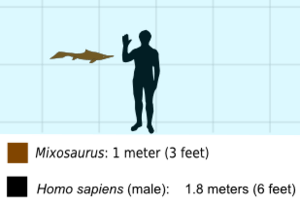Mixosaurus facts for kids
Quick facts for kids MixosaurusTemporal range: Middle Triassic
|
|
|---|---|
 |
|
| Mixosaurus sp. | |
| Scientific classification | |
| Kingdom: | |
| Phylum: | |
| Class: | |
| Order: | |
| Family: |
Mixosauridae
|
| Genus: |
Mixosaurus
|
Mixosaurus was a small, common ichthyosaur that lived during the Triassic period. Its name means "mixed lizard." These ancient marine reptiles were only about one meter (about 3 feet) long.
Fossils of Mixosaurus have been found in many places around the world. These include Alaska, Canada, China, Indonesia, Italy, Nevada (USA), New Zealand, and Svalbard. This shows that Mixosaurus lived in the ancient Tethys Sea and also traveled to other areas.
Mixosaurus is seen as a transitional form. This means it had features of both older, more basic ichthyosaurs (like Cymbospondylus) and newer, more advanced ones. The later ichthyosaurs looked more like modern dolphins or porpoises.
Contents
What Mixosaurus Looked Like
Mixosaurus was a small to medium-sized ichthyosaur. The biggest ones grew up to 2 meters (about 6.5 feet) long, but many species were only about 1 meter (3 feet) long.
It had a long tail with a small fin, which might mean it was a slow swimmer. However, it also had a dorsal fin (a fin on its back) to help it stay steady in the water. Its paddle-like limbs had five toes each. Later ichthyosaurs only had three toes.
Interestingly, each toe had more individual bones than most reptiles. Also, its front limbs were longer than its back limbs. These features are often seen in later, more advanced ichthyosaurs.
Mixosaurus had narrow jaws with many sharp teeth. These teeth were perfect for catching fish. Its skull was quite large compared to its body. This was different from earlier ichthyosaurs but similar to the fish-shaped ones that came later.
It had about 50 bones (vertebrae) in front of its hips. This is about twice as many as land-dwelling reptiles called diapsids. Recent studies suggest that Mixosaurus might have lived near the shore or in shallow waters. This is because its long bones had more compact spongy bone than other ichthyosaurs.
Types of Mixosaurus
Scientists currently recognize three main types, or species, of Mixosaurus:
- Mixosaurus cornalianus
- Mixosaurus panxianensis
- Mixosaurus kuhnschnyderi
These species look very similar in their bodies and skulls. The main differences are in their teeth and jaws. For example, they can differ in how far a groove in the upper jaw extends, the shape and size of their teeth, and how many rows of teeth they have.
Other species were once thought to be Mixosaurus, but scientists later reclassified them. These include M. atavus, M. callawayi, M. xindianensis, and M. yangjuanensis.
Mixosaurus cornalianus
Many fossils of Mixosaurus cornalianus have been found. They come from the Middle Triassic period in areas like Monte San Giorgio and Ticino (Tessin). These places are on the border between Italy and Switzerland.
Mixosaurus cornalianus is special because it's the only Triassic ichthyosaur for which complete skeletons have been found. Even though many specimens exist, they haven't been studied as much as they could be. This is because the fossils were squashed flat during the process of becoming preserved.
This species had a special ridge on its skull called a sagittal crest. This ridge was connected to strong jaw muscles, meaning it could bite down with great force.
Mixosaurus panxianensis
Mixosaurus panxianensis was found in the Middle Triassic rocks of Guizhou Province, China. The fossils were discovered in a place called the Guanling Formation. This area has thin layers of dark limestones and marls.
The fossils of Mixosaurus panxianensis show important features of Mixosaurus species, like the long sagittal crest on top of the skull. However, it's considered a different species because certain bones in its cheek area (the jugal and quadratojugal) don't touch each other.
Complete skeletons of this species have been found. The main parts of its vertebrae (backbones) are taller than they are long. This is important evidence that Mixosaurus panxianensis was a transitional form. It shows a link between the early Triassic ichthyosaurs and the more advanced species from the Jurassic and Cretaceous periods.
How Mixosaurus is Grouped
The way scientists group and classify mixosaurid ichthyosaurs has been a topic of debate recently. Most recently, the Mixosauridae family has been split into two main groups: Mixosaurinae and Phalarodontinae.
The Mixosaurinae group includes M. cornalianus, M. kuhnschnyderi, and M. panxianensis. The Phalarodontinae group includes species like P. fraasi, P. callawayi, and P. atavus from the genus Phalarodon.
Mixosaurids are known for having a relatively short and wide upper arm bone (humerus). Phalarodon species are known for not having a dental groove in their upper jaw. Fossils of Phalarodon are found in almost all the same places as Mixosaurus fossils.
Some Mixosaurus species have been called nomen dubium. This means their original descriptions weren't clear enough to fully classify them as a distinct species. Examples include M. maotaiensis, M. helveticus, and M. nordenskioeldii.
Scientists once thought that Tholodus schmidi should be part of the Mixosauridae family. However, only teeth of this animal have been found, which makes it hard to place it into a specific group.
Here is a cladogram (a diagram showing evolutionary relationships) based on scientific studies:
| Mixosauria |
|
||||||||||||||||||||||||||||||||||||
Images for kids
See also
 In Spanish: Mixosaurus para niños
In Spanish: Mixosaurus para niños





